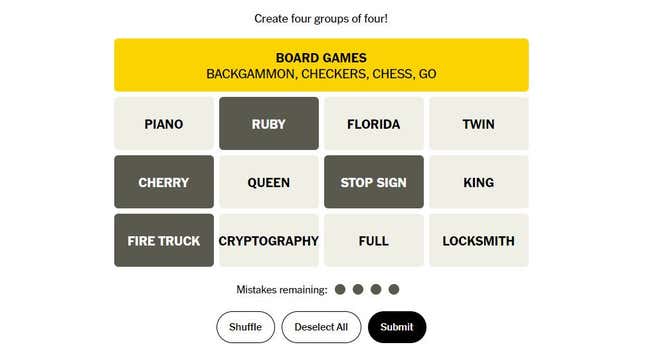Last week, the New York Times announced its latest puzzle had gone live for beta testing on its puzzling site. Joining the world famous crossword, and of course Wordle, is Connections. It’s a four-by-four grid of words, that you need to rearrange into four connecting groups. And if you happen to live in the UK, that’s going to sound incredibly similar to the Connecting Wall round on the BBC’s Only Connect.
As spotted by Eurogamer, this freshly announced new puzzle for the NYT is not just similar to the TV quiz show’s round, but uncannily so. So much so, in fact, that when the NYT’s Wyna Liu tweeted a link to the beta page for the game, Only Connect’s host, Victoria Coren-Mitchell replied observing how alike the two games are.
OK, quick explanation given that Only Connect perhaps doesn’t have quite the international recognition of something like Jeopardy. Starting in 2008, the BBC quiz show is probably the toughest, most intellectually challenging program in the country. Teams consist of extremely smart people with not just enormously broad and deep general knowledge, but also a keen mind for esoteric and lateral thinking.

This super-tough level of questions is balanced by the most endearingly cheerful and relaxed atmosphere, in huge part thanks to the enormously congenial presentation of Coren-Mitchell, but also helped by the fact that there are no prizes, no money to be won, and just a trophy at stake for the eventual winning team of the entire season.
It’s a low-key program in the UK, although in 2014 it saw its audience hugely increase after moving from BBC 4 to BBC 2 (um, like moving from Peacock to USA, I guess?). The Connecting Wall is the most famous round in the show, and online versions have been provided so viewers can play along at home. There’s a four-by-four grid of words, and the contestants have two-and-a-half minutes to solve it, by correctly identifying the four different connecting groups within the 16 tiles.
Which is, you know, a very accurate description of NYT’s Connections. In fact, the similarities go a lot further. On Only Connect, all the words start on blue tiles, then when correctly grouped change to dark blue, green, purple and light blue. On Connections, the exact same thing happens, but dark blue, green, purple and yellow. Yes, they introduced yellow.
It is, otherwise, functionally identical, but for a slight detail regarding how many guesses you get. On Only Connect, contestants can have as many guesses as they wish for the first two groups, but then are limited to three once only two groups are left. On Connections, players may only make four incorrect guesses throughout, giving it a more Wordle-like ability to share your results on social media.
This makes it all the more remarkable that in the New York Times’ reply to Eurogamer regarding the whole matter, they not only avoided the question over whether the puzzle had been inspired by Only Connect, but went so far as to call Connections “unique.” Which is facially false. It…it just isn’t. Their reply to Eurogamer read,
[T]he content of Connections is unique, handcrafted and has a distinctive style synonymous with New York Times Games.
There is another difference I noticed while playing today’s Connections. It’s also not very good. The Connecting Wall is a fiendish round, because it’s superbly crafted such that it’s packed with red herrings. There are many ways words can be grouped into threes, but not reach four, leading players down rabbit holes as they frantically attempt to crack the challenge. Not only that, but the groupings often require some lateral thinking, with one perhaps based on groups of letters appearing in the words, or possible extra letters that could be added to each to create other words—but only to those four. Meanwhile, today’s Connections has a group that is “Things that are red.” Yeah.
We’ve reached out to the New York Times to ask if they can clarify their bemusing claim that Connections is “unique,” given the 15-year-running TV show that prominently features the exact same puzzle, and whether their puzzle department has perhaps caught an episode.

